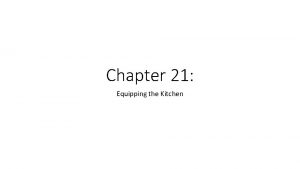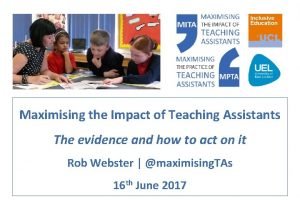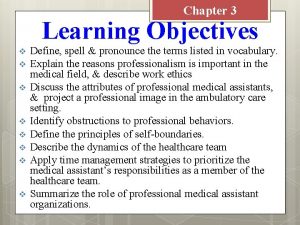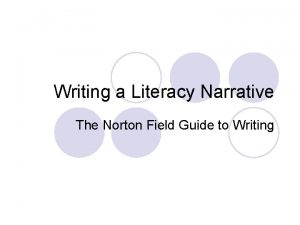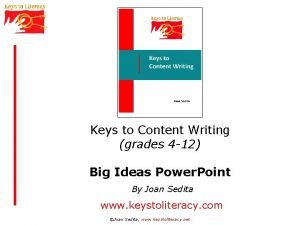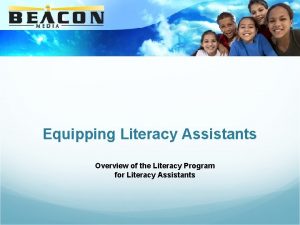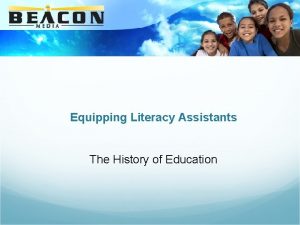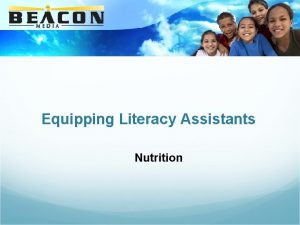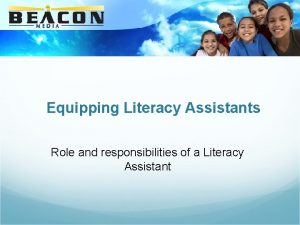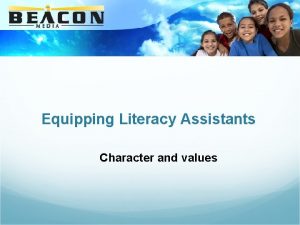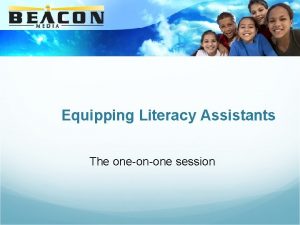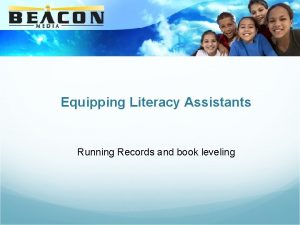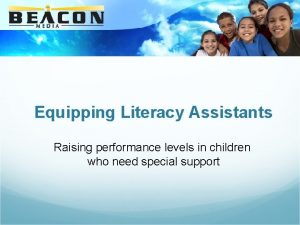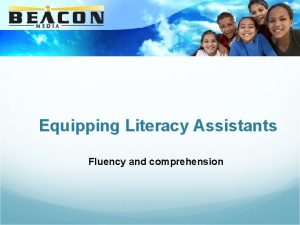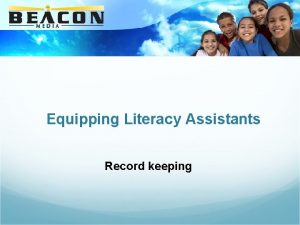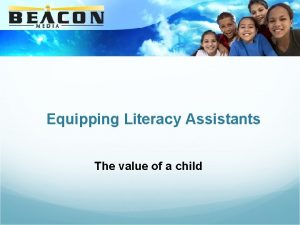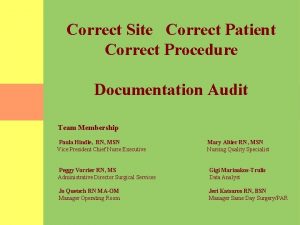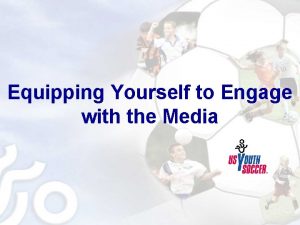Equipping Literacy Assistants Writing Handwriting Watch for Correct





















- Slides: 21

Equipping Literacy Assistants Writing

Handwriting Watch for: Correct grip of pencil Tall letters formed top to bottom Round letters like ‘o’ and ‘a’ start at 1 o’clock Spaces between words Writing on the line Not too small or large Not rushed

Tricks for ‘b’s and ‘d’s Lower case b – ‘a bat and a ball’ Lower case d – ‘a drum and a drumstick’ Lower case p – ‘a pole and a plate’

Written Expression Putting thoughts into words Putting those words into print Involves creative thinking, a good vocabulary, correct use of grammar, spelling and handwriting

Writing a sentence Beginners need to learn what a sentence is. A sentence is one idea. It has to have an action [verb]. It starts with a capital letter and ends with a full stop. The student has to create the sentence in their mind and say it out loud… not copy a sentence that someone else has thought of.

Predictable sentence starters For beginners, e. g. Today is ………… The weather is …………. After school I am going to …………….

Helping the student write a sentence Assistant says, “We are going to write a sentence together. ” “What would you like to write about? ” How will we start?

Using Thinking Hats to respond to a story Story sample: At the market (Level 1 story in the “Stories” folder). The Assistant helps the student write the answer. What else could you buy at the market? (Green Hat) How many fruits were in this story? (White Hat) What are your favourite foods from the market? (Yellow Hat)

Student response I could buy … There were ? fruits in the story. My favourite foods from the market are …. and ….

Different types of writing Example 1: Personal experience Example 2: How to make or do something Example 3: Facts about a topic Example 4: Answer questions about a story Example 5: A rhyme Example 5: A made up story

Personal experience Ask some questions such as: “What do you like to do on the weekend? ” “What did you do on the weekend? ” “What is your favourite place to go? ” What games do you like to play? ”

About themselves Make a book using repetitive sentences. Examples of sentence beginnings: I like to go …………………. . (Where else do you like to go? ) On Saturday I like to …………………. (What else to you like to do? ) I like to eat ………………. . (What else? )

How to make or do something How to play a game How to make a something to eat How to build a hut Start: “This is how you make/play/build …… “ 1. Get some …… 2. …. . Continue with numbered instructions …

Facts about a topic Sharks Volcanoes Anything that the student is interested in! After making up their sentence, the student can draw a picture

Sentence formation Ask: “Can you make an interesting sentence for me about sea creatures? ” Student response: “Lots of interesting things live under the sea. ”

Make a book about the topic If drawing takes up too much time the student could draw their picture in class or at home, and bring it back to you. Next session, think of a new sentence to illustrate on the same topic. When you have enough pages, staple together and make a book.

Topics of interest

Teach punctuation Teach capital letters, full stops and question marks. Then teach exclamation marks and speech marks.

Teach grammar Ask students to add describing words e. g. the student says, "The car went up the hill. ” Ask, “What was the car like? ” They add, ‘big’, little’ ‘red’ ‘old’ ‘new’ etc.

Help them write the words they cannot write Always get the student to use sounds. “What sound does that word start with? ” First let them ‘have a go’ on a scrap of paper. You can write some of the letters for tricky words. Don’t labour the sentence writing too long.

Activity Work with a partner. One will be the student, one will be the assistant. The assistant will encourage the student to make up and write a sentence by asking a question about a story. (Use the Thinking Hats but only choose one colour. ) Swap roles. This time the assistant will get the student to write a sentence about a topic of interest or a personal experience.
 Chapter 21 equipping the kitchen
Chapter 21 equipping the kitchen Making best use of teaching assistants
Making best use of teaching assistants Maximising the impact of teaching assistants
Maximising the impact of teaching assistants Scaffolding framework for teaching assistants
Scaffolding framework for teaching assistants Self boundaries for medical assistants
Self boundaries for medical assistants Pricewaterhouse
Pricewaterhouse Media literacy and information literacy similarities
Media literacy and information literacy similarities Media technology and information literacy venn diagram
Media technology and information literacy venn diagram Two step flow theory
Two step flow theory Cyber literacy for the digital age
Cyber literacy for the digital age Norton field guide literacy narrative
Norton field guide literacy narrative Key of content writing
Key of content writing Iso 22301 utbildning
Iso 22301 utbildning Typiska drag för en novell
Typiska drag för en novell Tack för att ni lyssnade bild
Tack för att ni lyssnade bild Ekologiskt fotavtryck
Ekologiskt fotavtryck Shingelfrisyren
Shingelfrisyren En lathund för arbete med kontinuitetshantering
En lathund för arbete med kontinuitetshantering Adressändring ideell förening
Adressändring ideell förening Tidbok för yrkesförare
Tidbok för yrkesförare A gastrica
A gastrica Densitet vatten
Densitet vatten
